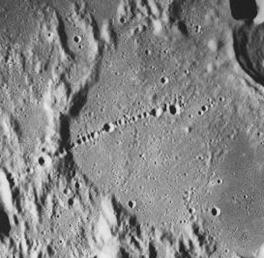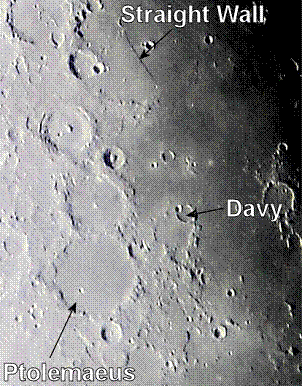Lunar Challenge - Catena Davy
Jack Kramer
If we happen to observe small lunar craters all stretched out in a row, it makes us wonder what might have caused this. There are a variety of possibilities.
- Some are endogenic, meaning they originated from activity within the Moon itself. Examples of this type include those that lie within rills, suggesting they were caused by subsidence or volcanism.
- Secondary crater chains on the Moon are common. Such chains are generally radial to a large crater, occur near other such chains, and have raised rims with "chevron" imprints between craters that point back to the primary. Clearly, they were formed from debris thrown out of the large crater upon impact. We also find craterlets distributed in a haphazard line around some large craters, such as Copernicus.
- Several crater chains on the Moon and elsewhere in the Solar System don't seem to fit either of the two previous scenarios. The mystery was solved in 1993 with the discovery of Comet Shoemaker-Levy 9. As you recall, it was not a single comet, but a chain of twenty-one comet fragments created a year earlier when Jupiter's gravity tore apart the original comet. SL-9 crashed into Jupiter in 1994, and we can visualize that if Jupiter had a solid surface, a chain of craters would probably have resulted from any particles of SL-9 that survived passage through the atmosphere. In fact, such crater chains have been found on Jupiter's Moons Callisto and Ganymede.
We now know that fragmented comets are not unusual. Sunlight alone can shatter their fragile nuclei. The breakup of Comet Schwasmann-Wachmann 3 is a recent example. And there's evidence that many asteroids are really aggregates of dust and rock barely held together by a slight bit of gravity. If these things were to hit a terrestrial object, they'd likely make chains of craters. If you haven't already guessed, the word "catena" is a Latin term adopted by the International Astronomical Union to signify a chain of small craters.
In 1994, Jay Melosh and Ewen Whitaker announced their finding of two crater chains on the Moon, neither of which appears endogenic or secondary to a larger impact. One fairly large chain is near the crater Abulfeda and the other lies near Davy. The Davy crater chain is particularly interesting because it's an almost perfect line of twenty-three pockmarks each only a few miles in diameter. This is significant because it proves that multiple-impact events and resulting crater chains have indeed occurred in our Earth-Moon system.
This chain of craterlets doesn't actually lie within Davy, but in the larger, highly eroded crater basin with Davy at the (lunar) west edge. This basin is referred-to as "Davy Y". The image below from the Lunar Orbiter spacecraft clearly shows the chain stretching across Davy Y and up onto the walls of the basin (part of the crater Davy is seen at the upper right edge of the image).
 To help in locating the site, the following is an image of the area that I took through a 4-inch refractor. It shows Davy in relation to the large ruined crater Ptolemaeus and the famous "Straight Wall".
To help in locating the site, the following is an image of the area that I took through a 4-inch refractor. It shows Davy in relation to the large ruined crater Ptolemaeus and the famous "Straight Wall".
 The crater chain doesn't show up in the above picture, but you might be able to see a faint light-colored line stretching across Davy Y. This follows the line of craterlets, so at first I thought it might be lunar surface material ("regolith") scattered as the pieces of space debris impacted the Moon. Checking a number of lunar atlases, the light line shows up in wide-field images, but not close-ups. That suggests it's more likely to be sunlight brightening the rims of the craterlets; an inability to resolve individual craters may cause the reflected points of light to knit together into what looks like a continuous line. This seems to be confirmed by close inspection of Clementine Mission imagery. Its visibility also may depend on the angle at which sunlight strikes it. In my 6-inch refractor, the smaller craters appeared to reflect a lot of sunlight, making them visible sometimes as mere points of light.
The crater chain doesn't show up in the above picture, but you might be able to see a faint light-colored line stretching across Davy Y. This follows the line of craterlets, so at first I thought it might be lunar surface material ("regolith") scattered as the pieces of space debris impacted the Moon. Checking a number of lunar atlases, the light line shows up in wide-field images, but not close-ups. That suggests it's more likely to be sunlight brightening the rims of the craterlets; an inability to resolve individual craters may cause the reflected points of light to knit together into what looks like a continuous line. This seems to be confirmed by close inspection of Clementine Mission imagery. Its visibility also may depend on the angle at which sunlight strikes it. In my 6-inch refractor, the smaller craters appeared to reflect a lot of sunlight, making them visible sometimes as mere points of light.
Observing the Davy crater chain will test the quality of your telescope optics. This is one of those features that calls for high magnification. Bear in mind that even the largest of these craterlets is only a few miles wide. The best time to view is when the Moon is around 8 days old (just past first quarter) with strong shadows. The Straight Wall is a good indicator - if you can see it as a black line, then there is sufficient shadowing to see at least the largest craters of the Davy chain. But I've clearly seen the entire chain in the 6-inch refractor at 300x when the Moon was nearly 11 days old. The larger craterlets in the chain appear to be pretty deep, so shadows linger for quite awhile. The resolution of a large telescope is helpful, but not required so long as the optical quality is good. Many years ago I tried with an 80mm refractor, but could only detect a light-colored line where the crater chain lies. More recently I caught sight of the three largest craterlets on the floor of Davy Y using the 4-inch refractor at a little over 200x. They were at the edge of resolution, becoming apparent off and on as seeing conditions fluctuated. The craters superimposed on the wall of Davy Y were visible in the 6-inch, but not in the 4-inch.
The Moon fascinates people at public star parties, though we amateurs often regard it as a bit of a nuisance. But I find that challenges such as the Davy chain prod me to spend more quality time with our Moon.
Published in the January 2007 issue of the NightTimes




